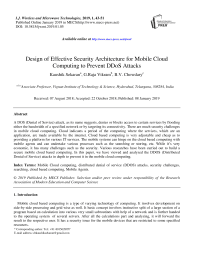Design of effective security architecture for mobile cloud computing to prevent DDoS attacks
Автор: Kaushik Sekaran, G.Raja Vikram, B.V. Chowdary
Журнал: International Journal of Wireless and Microwave Technologies @ijwmt
Статья в выпуске: 1 Vol.9, 2019 года.
Бесплатный доступ
A DOS (Denial of Service) attack, as its name suggests, denies or blocks access to certain services by flooding either the bandwidth of a specified network or by targeting its connectivity. There are much security challenges in mobile cloud computing. Cloud indicates a period of the computing where the services, which are an application, are made available by the internet. Cloud based computing is very adjustable and cheap as to providing a platform for various IT services. The mobile systems can hinge on the cloud based computing with mobile agents and can undertake various processes such as the searching or storing, etc. While it’s very economic, it has many challenges such as the security. Various researches have been carried out to build a secure mobile cloud based computing. In this paper, we have viewed and analyzed the DDOS (Distributed Denial of Service) attacks in depth to prevent it in the mobile cloud computing.
Mobile Cloud computing, distributed denial of service (DDOS) attacks, security challenges, searching, cloud based computing, Mobile Agents
Короткий адрес: https://sciup.org/15016959
IDR: 15016959 | DOI: 10.5815/ijwmt.2019.01.05
Список литературы Design of effective security architecture for mobile cloud computing to prevent DDoS attacks
- Hunter, P. (2003). Distributed Denial of Service (DDOS) Mitigation Tools.Network Security, 2003(5), 12-14.
- Beitollahi, H., & Deconinck, G. (2012). Analyzing well-known countermeasures against distributed denial of service attacks. Computer Communications, 35(11), 1312-1332.
- Lee, K., Kim, J., Kwon, K. H., Han, Y., & Kim, S. (2008). DDoS attack detection method using cluster analysis. Expert Systems with Applications,34(3), 1659-1665.
- Agarwal, S., Dawson, T., Tryfonas, C. (2003). DDoS mitigation via regional cleaning centers. Sprint ATL Research Report RR04-ATL-013177.
- Yaar, A., Perrig, A., & Song, D. (2004, May). SIFF: A stateless Internet flow filter to mitigate DDoS flooding attacks. In Security and Privacy, 2004.Proceedings. 2004 IEEE Symposium on (pp. 130-143). IEEE.
- Y. Chen, K. Hwang, W.-S. Ku, Collaborative detection of DDoS attacks over multiple network domains, IEEE Transactions on Parallel and Distributed Systems 18 (12) (2007) 1649–1662.
- L. Feinstein, D. Schnackenberg, R. Balupari, D. Kindred, Statistical approaches to DDoS attack detection and response, in: Proceedings of DARPA Information Survivability Conference and Exposition, Washington, DC, USA, 2003, pp. 303–314.
- A.L. Toledo, X. Wang, Robust detection of MAC layer denial-of-service attacks in CSMA/CA wireless networks, IEEE Transactions on Information Forensics and Security 3 (3) (2008) 347–358.
- P. Ferguson, D. Senie, Network ingress filtering: defending denial of service attacks which employ IP source address spoofing, internet RFCs RFC 2827, 2000, pp. 1–10.
- K. Park, H. Lee, On the effectiveness of route-based packet filtering for distributed DoS attack prevention in power-law internets, in: Proceedings of ACM SIGCOMM, San Diego, California, USA., 2001, pp. 15–26.
- Soeung-Kon(Victor) Ko, Jung-Hoon Lee, Sung Woo Kim,Mobile cloud computing security considerations, January 2012.
- Sekaran Kaushik and P. Venkata Krishna. "Big Cloud: a hybrid cloud model for secure data storage through cloud space." International Journal of Advanced Intelligence Paradigms 8, no. 2 (2016), pp. 229-241.
- Sekaran, K., & Krishna, P. V. (2017). Cross region load balancing of tasks using region-based rerouting of loads in cloud computing environment. International Journal of Advanced Intelligence Paradigms, 9(5-6), pp. 589-603.
- Sung, M., Xu, J. (2003). IP traceback-based intelligent packet filtering: a novel technique for defending against Internet DDoS attacks. IEEE Transactions on Parallel and Distributed Systems, 14(9), pp. 861-872.


